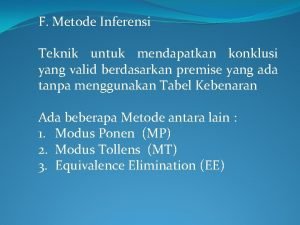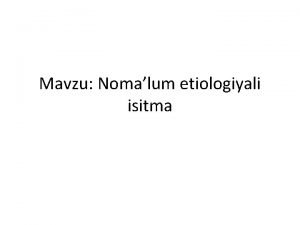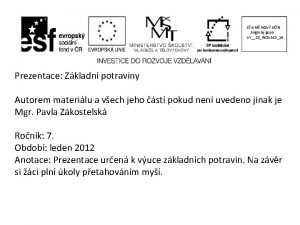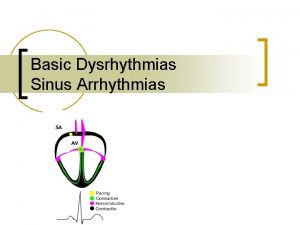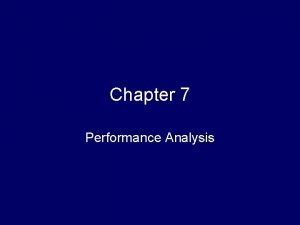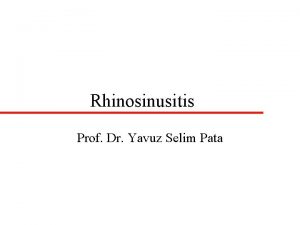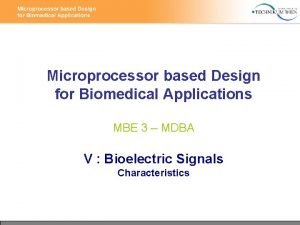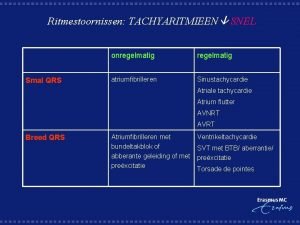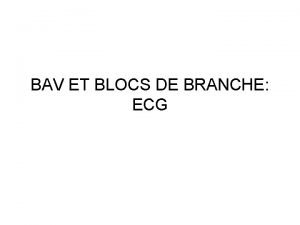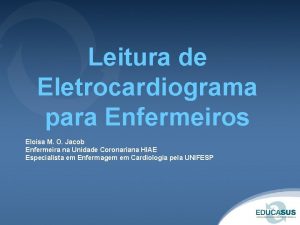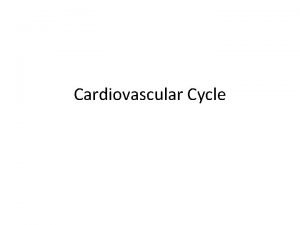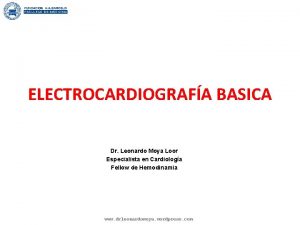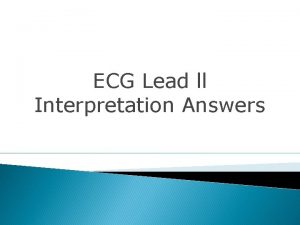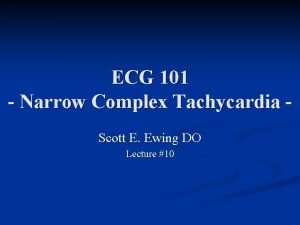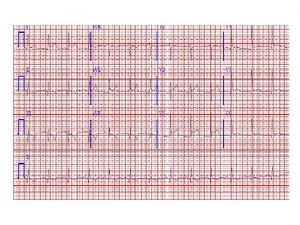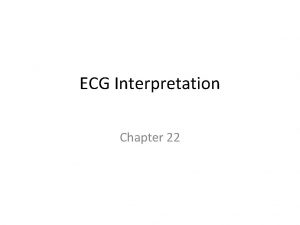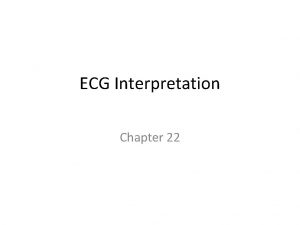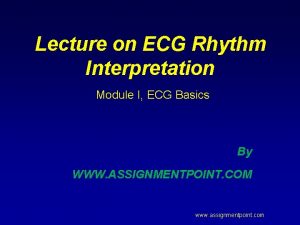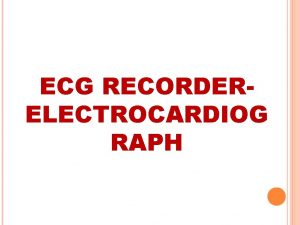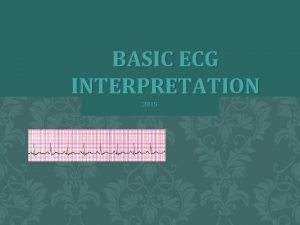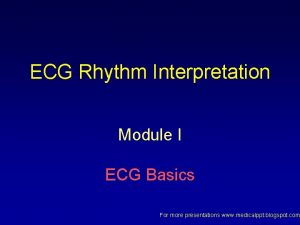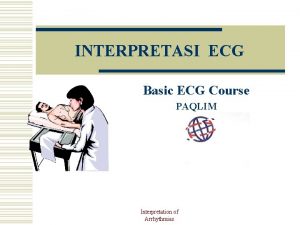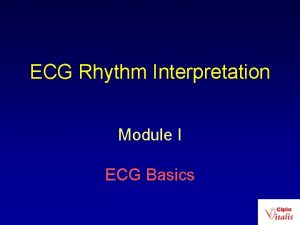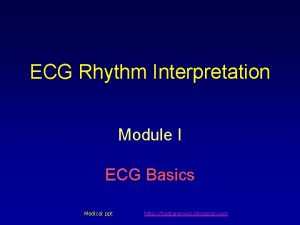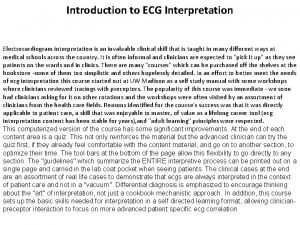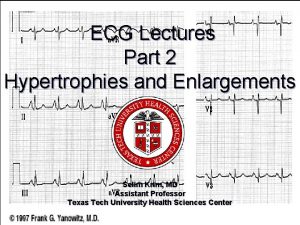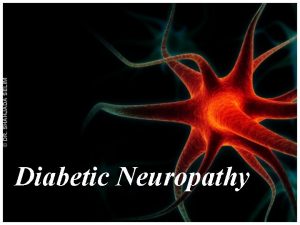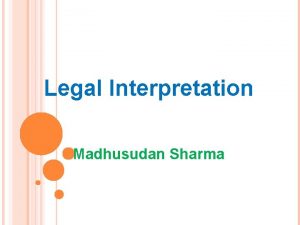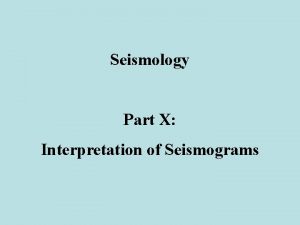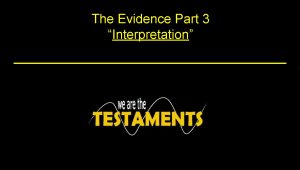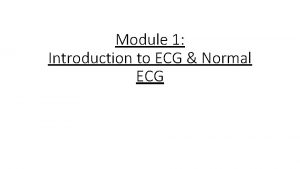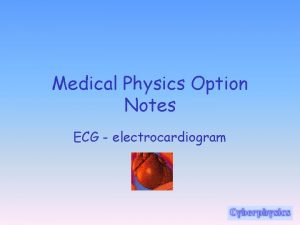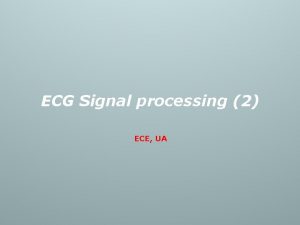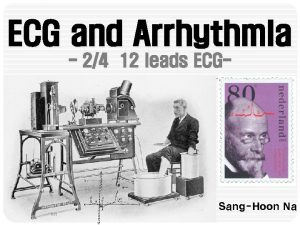ECG Lecture Part 1 ECG Interpretation Selim Krim










































- Slides: 42

ECG Lecture Part 1 ECG Interpretation Selim Krim, MD Assistant Professor Texas Tech University Health Sciences Center

Step wise approach to ECG Measurements Rhythm Analysis Conduction Analysis Waveform Description ECG Interpretation Comparison with Previous ECG (if any)

Measurements Heart rate 60 -90 bpm PR interval (from beginning of P to beginning of QRS) =0. 12 -0. 20 sec QRS duration (width of most representative QRS) <0. 12 sec QT interval (from beginning of QRS to end of T) = 0. 42 sec QRS axis in frontal plane

Measurements

Heart rate State atrial and ventricular rate. P wave rate 60 -100 bpm Rate < 60 = Sinus bradycardia Rate > 90 = Sinus tachycardia

How to calculate Heart Rate Standard textbooks of physiology and medicine mention that heart rate (HR) is readily calculated from the ECG as follows: HR = 1, 500/RR interval in millimeters, HR = 60/RR interval in seconds, or HR = 300/number of large squares between successive R waves

Measurements

Measurements

The P wave represents atrial activation; the PR interval is the time from onset of atrial activation to onset of ventricular activation. The QRS complex represents ventricular activation; the QRS duration is the duration of ventricular activation. The ST-T wave represents ventricular repolarization. The QT interval is the duration of ventricular activation and recovery. The U wave probably represents "after depolarizations" in the ventricles.

How To Determine Axis

How To Determine Axis

How To Determine Axis

How To Determine Axis

How to Determine Axis

How to Determine Axis

Step wise approach to ECG Measurements Rhythm Analysis Conduction Analysis Waveform Description ECG Interpretation Comparison with Previous ECG (if any)

Rhythm Analysis State basic rhythm (e. g. , "normal sinus rhythm", "atrial fibrillation", etc. ) Identify additional rhythm events if present (e. g. , "PVC's", "PAC's", etc) Consider all rhythm events from atria, AV junction, and ventricles

Rhythm Analysis Sinus rhythm defined as; Each P wave is followed by QRS P wave is positive in lead I, II Constant PR interval

Rhythm Analysis

Rhythm Analysis

Step wise approach to ECG Measurements Rhythm Analysis Conduction Analysis Waveform Description ECG Interpretation Comparison with Previous ECG (if any)

Conduction Analysis

Conduction Analysis Sino-Atrial Exit Block (SA Block): Type 1, 2 Atrio-Ventricular (AV) Block: 1 st, 2 nd and 3 rd degree AV Dissociation Intraventricular Blocks; RBBB, LAFB, RPFB, Bifascicular Nonspecific Intraventricular Conduction Defects (IVCD) Wolff-Parkinson-White Preexcitation

Step wise approach to ECG Measurements Rhythm Analysis Conduction Analysis Waveform Description ECG Interpretation Comparison with Previous ECG (if any)

Waveform Description Carefully analyze the 12 -lead ECG for abnormalities in each of the waveforms in the order in which they appear: P waves: are they too wide, too tall, look funny (i. e. , are they ectopic), etc. ? QRS complexes: look for pathologic Q waves, abnormal voltage, etc. ST segments: look for abnormal ST elevation and/or depression. T waves: look for abnormally inverted T waves. U waves: look for prominent or inverted U waves.

Waveform Description

Waveform Description

Waveform Description

Waveform Description

The normal U wave has the same polarity as the T wave and is usually less than one -third the amplitude of the T wave. U waves are usually best seen in the right precordial leads especially V 2 and V 3. The normal U wave is asymmetric with the ascending limb moving more rapidly than the descending limb (just the opposite of the normal T wave).

Step wise approach to ECG Measurements Rhythm Analysis Conduction Analysis Waveform Description ECG Interpretation Comparison with Previous ECG (if any)

ECG Interpretation This is the conclusion of the above analyses. Interpret the ECG as "Normal", or "Abnormal". Occasionally the term "borderline" is used if unsure about the significance of certain findings. List all abnormalities. Examples of "abnormal" statements are: Inferior MI, probably acute Old anteroseptal MI Left anterior fascicular block (LAFB) Left ventricular hypertrophy (LVH) Nonspecific ST-T wave abnormalities Any rhythm abnormalities

Step wise approach to ECG Measurements Rhythm Analysis Conduction Analysis Waveform Description ECG Interpretation Comparison with Previous ECG (if any)

Let’s practice!

ECG 1

ECG 2

ECG 3

ECG 4

ECG 5

ECG 6

Questions ?

Thank you
 Toni membeli es krim
Toni membeli es krim Ku isitma
Ku isitma Ajs krim
Ajs krim Ecg rhythm strip interpretation basic lesson 6
Ecg rhythm strip interpretation basic lesson 6 How does interpretation b differ from interpretation a
How does interpretation b differ from interpretation a 01:640:244 lecture notes - lecture 15: plat, idah, farad
01:640:244 lecture notes - lecture 15: plat, idah, farad Selim aksoy bilkent
Selim aksoy bilkent Selim opilec
Selim opilec Bilkent matlab
Bilkent matlab Sinan mosque of selim ii
Sinan mosque of selim ii Bilkent matlab
Bilkent matlab Yavuz sultan selim mosque
Yavuz sultan selim mosque Too many input arguments.
Too many input arguments. Selim aksoy bilkent
Selim aksoy bilkent Selim akl
Selim akl Magdy selim
Magdy selim Prof dr selim gürel
Prof dr selim gürel Selim aksoy
Selim aksoy Yavuz selim pata
Yavuz selim pata Linear filtering
Linear filtering Selim aksoy bilkent
Selim aksoy bilkent Part whole model subtraction
Part whole model subtraction Parts of a bar graph
Parts of a bar graph Part to part ratio definition
Part to part ratio definition The part of a shadow surrounding the darkest part
The part of a shadow surrounding the darkest part Brainpop ratios
Brainpop ratios Part to part variation
Part to part variation Technical description examples
Technical description examples Ecg measurement
Ecg measurement Smal complex tachycardie
Smal complex tachycardie Fast and easy ecg
Fast and easy ecg Hbpg ecg
Hbpg ecg Watch?v=0evgft8hgns
Watch?v=0evgft8hgns Sincício
Sincício Ecg breakdown
Ecg breakdown Eje ecg
Eje ecg Ecg gel composition
Ecg gel composition Bloqueio de ramo direito
Bloqueio de ramo direito Pcbases
Pcbases How to count rate on ecg
How to count rate on ecg Avnrt
Avnrt Capture beat
Capture beat Types of pathology
Types of pathology
